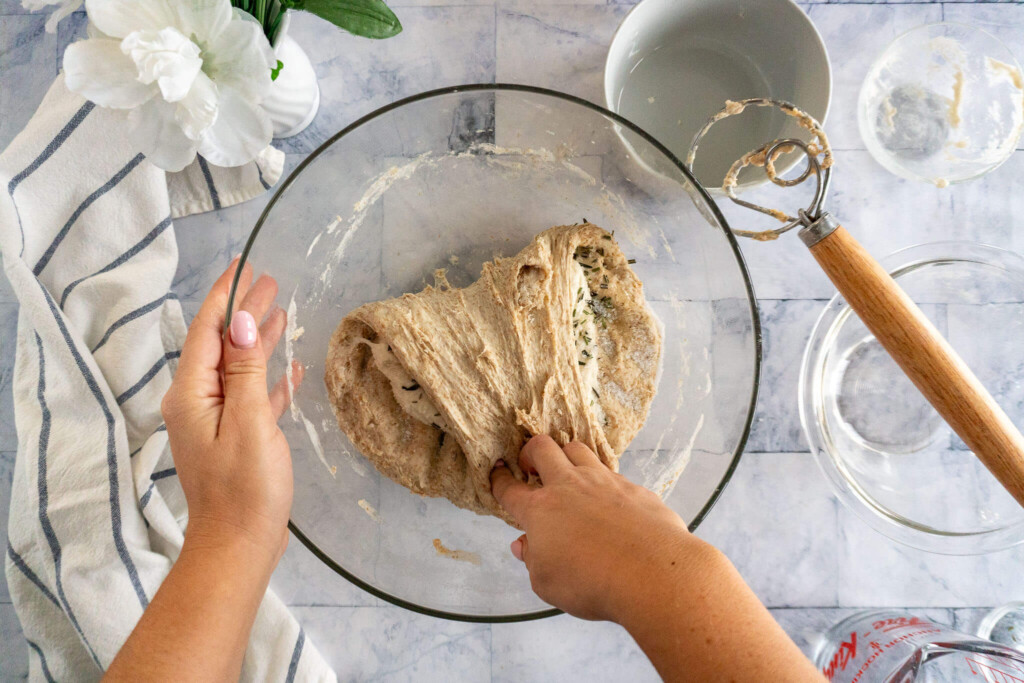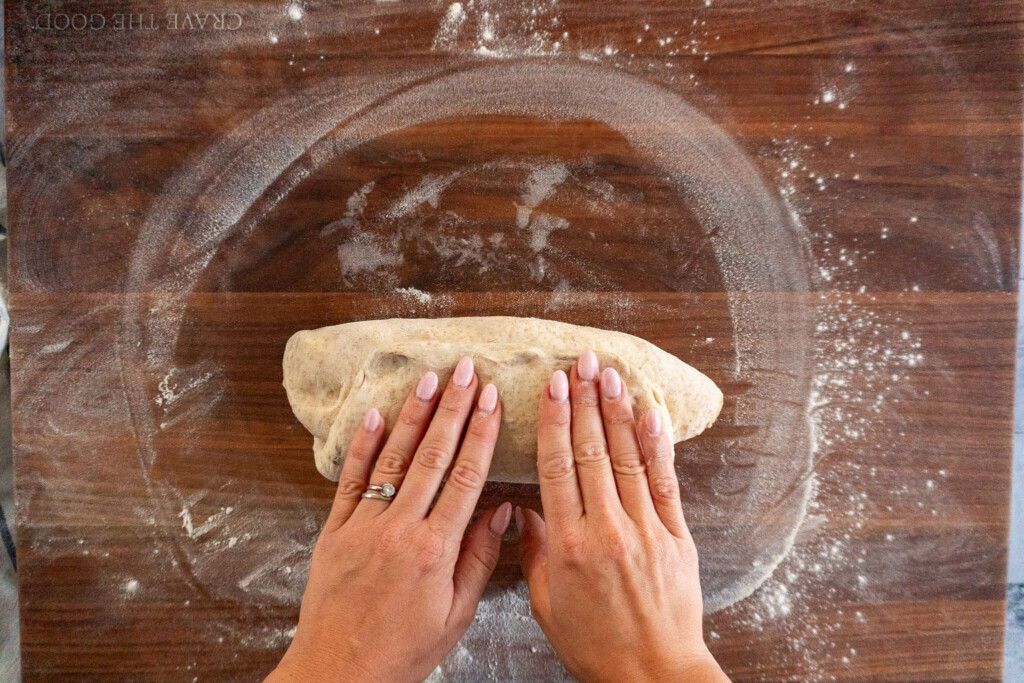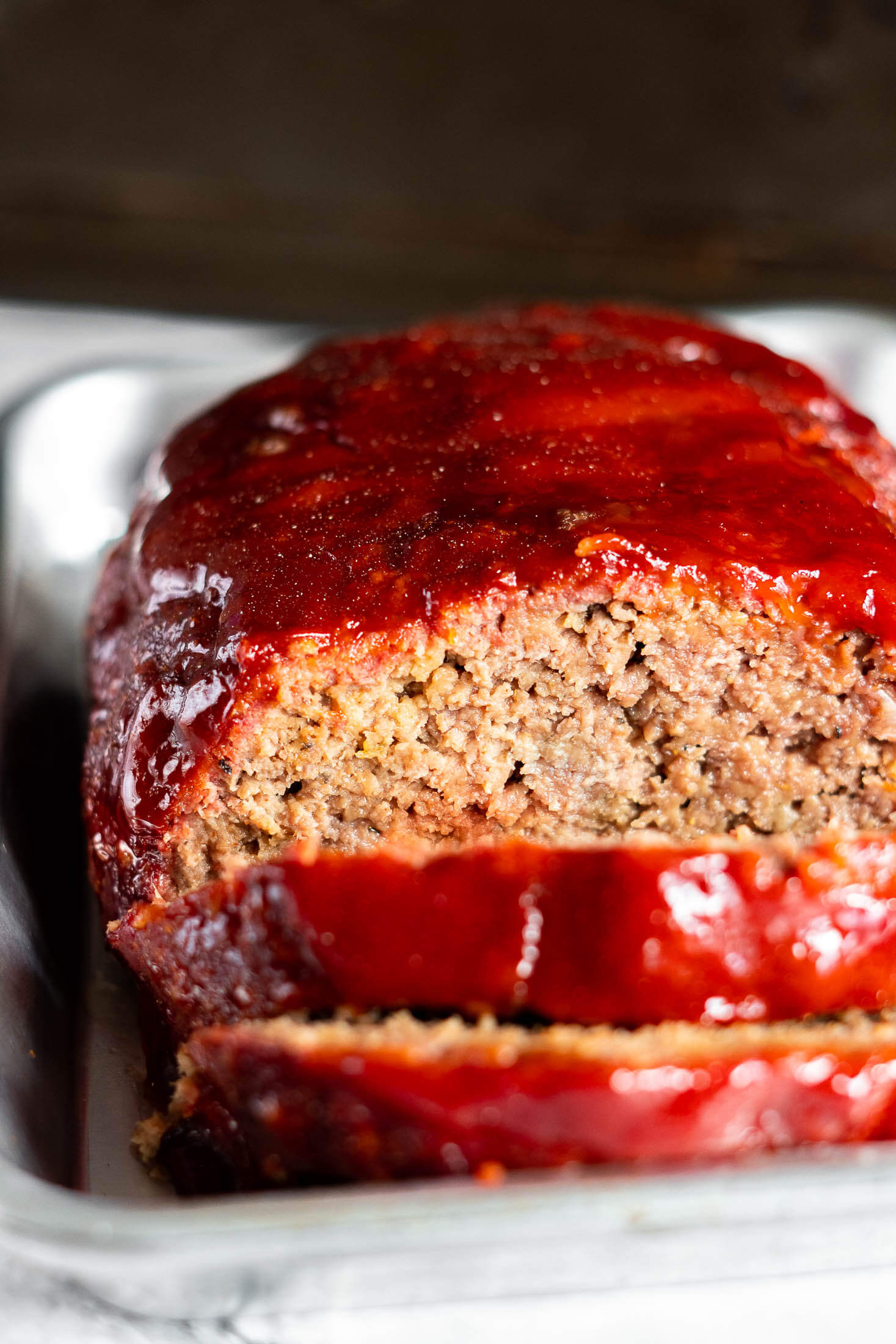Rosemary Sourdough Bread
As an Amazon Associate I earn from qualifying purchases.
Rosemary sourdough starts with a hearty base of whole wheat flour, giving the loaf a rich, nutty flavor and is enhanced by sweet, raw honey from my homestead honey bees, infusing it with a subtle sweetness to balance out the savory notes.
Fresh rosemary is incorporated throughout the dough, creating beautiful green specks in every slice and full flavor in every bite, while the sourdough process adds another layer of complexity to this bread. Fermentation gives the loaf a slightly tangy flavor and a chewy texture, making it perfect for toasted tomato sandwiches or simply enjoyed on its own.
As an added bonus, this one bowl recipe does not require any fancy equipment or stand mixer to knead sourdough. It’s easy to make, and easy to clean up!
This rosemary sourdough bread recipe is dedicated to tomato sandwiches.

Jump to:
Key Ingredients
Sourdough Starter: For this recipe, you want to use a fed and active sourdough starter. Your starter should be fed approximately 8 hours before beginning and have at least doubled in size.
Rosemary: Fresh rosemary offers the best flavor in this recipe. If you don’t have fresh rosemary, the next best option is frozen. I harvest sprigs of rosemary in the fall and freeze them for winter recipes all the time! Dried rosemary can be substituted at a rate of 1 scant teaspoon per 1/2 tablespoon.
Psst.. Need a sourdough starter recipe? Want to know more about feeding your starter, storing sourdough starter, how to use discard, or even which is the best jar for your starter? I’ve got tons of guides to help you!

How To Make Rosemary Sourdough Bread
Autolyse:
- In a large mixing bowl, combine 340g warm water with 275g bread flour and 225g whole wheat flour and mix until a shaggy dough forms. Knead the dough with your hands until all the dry bits are incorporated.
- Cover the bowl and set aside to autolyse for 30 – 60 minutes.




Add Sourdough Starter:
- Uncover the bowl and spread the dough in the bowl, I just poke it flat with my fingers, and spread 100g sourdough starter, 40g honey, 1/2 tablespoons chopped rosemary, and 14g fine sea salt across the surface of the dough.
- Using damp hands, grab the dough and gently pull it until the flap is long enough to fold over itself, then fold the flap, rotate the bowl 90 degrees, and repeat 4 times to fold in the starter. Once the starter, and honey are completely enclosed in by the stretch and folds, stop as continuing can cause the dough to become sticky. Don’t panic if the dough feels a bit wet or gooey, it will come together -it’s just more annoying to work with.
- Recover and set aside for 1 hour.




Stretch And Fold:
- Uncover and perform a set of stretch and folds. Recover and set aside for 1 hour before performing another set of stretch and folds before recovering. If the dough is not coming together after the second set of stretch and folds, turn it out onto a floured surface and knead it with a little bit of flour till it comes together before covering and resting for 1 hour.
- Repeat once more, for a total of 3 sets of stretch and folds.
- Then cover, and set aside for 2 hours to finish the bulk ferment.




Shape:
- Uncover the dough and transfer to a work surface or countertop. Gently press and spread the dough into a large rectangle.
- Fold up the bottom third of the dough as though you were folding a letter, and then fold the top down.
- Rotate the dough 90 degrees and roll up into a large log. Cover with a kitchen or tea towel and rest for 30 minutes.
- After the rest, pick up the dough with a dough scraper and flip it over, gently press the dough flat then roll it again. Pinch the ends if you’re making a batard or tuck them in if your making a boule.
- Dust the dough with rice flour then tuck seam side up into a banneton.
Don’t have a banneton basket? I have a guide on bannetons and banneton alternatives!




Prove + Cold Retard:
- Prove the rosemary sourdough loaf in the banneton for 2 hours in a warm place before covering and placing in fridge to cold retard for up to 3 days. If you want to bake it right after proving, you’re welcome to, but the flavor is better after resting in the fridge.
Bake:
- Place your dutch oven, cloche, or desired baking dish in the oven and preheat to 450f. If you don’t have a dutch oven, I do have a guide on Sourdough bread baking without a dutch oven.
- Once the oven is preheated, invert the banneton onto a sheet of parchment paper.
- Use a lame, sharp knife, or clean razor blade to score the dough, I usually like to make one deep curved slash, but you can get as fancy as you like!
- Carefully remove the dutch oven from the oven, and using the parchment paper as a sling, transfer the sourdough loaf from the counter into the dutch oven.
- Bake the dough at 450f covered for 30 minutes and uncovered at 450f for 10-15 minutes, or until the loaf is cooked through and the crust is nicely browned. You can test the doneness of the loaf with an instant-read thermometer. Bread is cooked once it reaches 205 – 210 degrees Fahrenheit internal temperature.




Cool:
- Remove baked bread from the dutch oven and transfer it to a wire mesh cooling rack to cool completely before slicing. I like to leave it for at least 2 hours before slicing, as slicing too soon can affect the crumb and texture of your loaf.
Try These Sourdough Bread Recipes:
Tips
- I developed this recipe to have a subtle rosemary flavor, I find it to be more versatile that way. If you’re looking to have more rosemary punch, double the amount of chopped rosemary to 1 tablespoon.
- This recipe has a high proportion of whole grain flour, so we’ll be using a little bit of baking magic called autolyse. This easy process helps to improve the texture of the baked bread and improve gluten structure in the dough.
- I recommend using bread flour in conjunction with whole wheat in this recipe because whole wheat has the tendency to result in dense baked goods while bread flour, with its high protein content, provides a lot of structure. In a pinch, you could sub all of the whole wheat with bread flour.
- Use this recipe as a base! Feel free to add other flavors. I think that smoked garlic, smoked onions, fermented garlic, sun dried tomatoes, or even dehydrated cherry tomatoes would be amazing paired with rosemary this recipe!
- If after the second stretch and fold the dough is looking a little ragged, don’t fret, that can happen when adding honey after autolyse. Turn the dough onto a floured surface and knead it with a little bit of flour till it comes together then continue along with the recipe.

Batch + Storage
Batch:
This rosemary sourdough recipe makes one large boule or batard. This is enough for my family of 4 to snack on for at least 2 days! It can be doubled to make 2 loaves, or tripled, if desired.
Storage:
If you’ve got leftover sourdough, you’ve got serious willpower! There are a couple of ways to store sourdough bread to help prolong its quality after cutting.
Your loaf can be kept cut side down on a cutting board for up to 12 hours before the crust becomes too crisp. This is our go-to. I recommend transferring it to a bread bag after 16-18 hours though.
Your sourdough loaf can also be frozen. To freeze sourdough, cool the loaf to room temperature, then tightly wrap it in plastic wrap, slide it into a bread bag, seal it up, and stick it in the freezer for 1-2 months. To use after freezing, remove the loaf from the freezer, unwrap, and allow it to come to room temperature (1 -2 hours) before slicing and enjoying.

Our Favorite
Flavored Sourdough Recipes
Recommended Equipment
Cast iron dutch oven: Much of the success of this bread depends on having a heavy-ass cast iron dutch oven, as it traps in steam and boosts the oven spring of your sourdough.
The blue one in these photos is a large oval dutch oven that I find perfect for baking batards. As an added bonus, due to the shape, I can fit this dutch oven and a round one in the oven to bake double the volume! If you don’t have a dutch oven, I have a guide on baking sourdough bread without a dutch oven.
Scale: It’s really hard to make sourdough without a scale. Sorry, but them’s the facts! bread baking and bread dough are a bit of a science. A good kitchen scale will treat you well over a huge range of recipes, not just sourdough. Think of homemade bacon!

If you love this recipe, please give it a star rating or leave a comment below! This helps me to create more content you enjoy!
Want To Save This Recipe?
I’ll send the ingredient list and instructions right to you!
📖 Printable Recipe

Rosemary Sourdough Bread
Ingredients
- 340 g water warm
- 275 g bread flour
- 225 g whole wheat flour
- 100 g sourdough starter active
- 40 g raw honey
- 14 g fine sea salt
- ½ tablespoon fresh rosemary chopped
Instructions
Autolyse:
- In a large mixing bowl, combine 340g warm water with 275g bread flour and 225g whole wheat flour and mix until a shaggy dough forms. Knead the dough with your hands until all the dry bits are incorporated.
- Cover the bowl and set aside to autolyse for 30 – 60 minutes.
add sourdough starter:
- Uncover the bowl and spread the dough in the bowl, I just poke it flat with my fingers, and spread 100g sourdough starter, 40g honey, 1/2 tablespoons chopped rosemary, and 14g fine sea salt across the surface of the dough.
- Using damp hands, grab the dough and gently pull it until the flap is long enough to fold over itself, then fold the flap, rotate the bowl 90 degrees, and repeat 4 times to fold in the starter. This is considered one set of stretch and folds. Don't panic if the dough feels a bit wet or gooey, it will come together during the later.
- Recover and set aside for 1 hour.
stretch and fold:
- Uncover and perform a set of stretch and folds. Recover and set aside for 1 hour before performing another set of stretch and folds before recovering. If the dough is not coming together after the second set of stretch and folds, turn it out onto a floured surface and knead it with a little bit of flour till it comes together before covering and resting for 1 hour.
- Repeat once more, for a total of 3 sets of stretch and folds. Then cover, and set aside for 2 hours to finish the BULK FERMENT.
shape:
- Uncover the dough and transfer to a work surface or countertop. Gently press and spread the dough into a large rectangle.
- Fold up the bottom third of the dough as though you were folding a letter, and then fold the top down.
- Rotate the dough 90 degrees and roll up into a large log. Cover with a kitchen or tea towel and rest for 30 minutes.
- After the rest, flip the dough over, gently press the dough flat then roll it again. Pinch the ends if you're making a batard or tuck them in if your making a boule.
- Dust the dough with rice flour then tuck seam side up into a BANNETON.
prove + cold retard:
- Prove the rosemary sourdough loaf in the banneton for 2 hours before covering and placing in fridge to cold retard for up to 3 days. If you want to bake it right after proving, you're welcome to, but the flavor is better after resting in the fridge.
bake:
- Place your dutch oven, cloche, or desired baking dish in the oven and preheat to 450f. If you don't have a dutch oven, I do have a guide on BAKING SOURDOUGH BREAD WITHOUT A DUTCH OVEN.
- Once the oven is preheated, invert the banneton onto a sheet of parchment paper.
- Use a lame, sharp knife, or clean razor blade to score the dough, I usually like to make one deep curved slash, but you can get as fancy as you like!
- Carefully remove the DUTCH OVEN from the oven, and using the parchment paper as a sling, transfer the sourdough loaf from the counter into the dutch oven.
- Bake the dough at 450f covered for 30 minutes and uncovered at 450f for 10-15 minutes, or until the loaf is cooked through and the crust is nicely browned. You can test the doneness of the loaf with an instant-read thermometer. Bread is cooked once it reaches 205 – 210 degrees Fahrenheit internal temperature.
cool:
- Remove baked bread from the dutch oven and transfer it to a wire mesh cooling rack to cool completely before slicing. I like to leave it for at least 2 hours before slicing, as slicing too soon can affect the crumb and texture of your loaf.
Notes
Flavor Notes:
I developed this recipe to have a subtle rosemary flavor, I find it to be more versatile that way. If you're looking to have more rosemary punch, double the amount of chopped rosemary to 1 tablespoon.Batch:
Storage:
If you've got leftover sourdough, you've got serious willpower! There are a couple of ways to STORE SOURDOUGH BREAD to help prolong its quality after cutting. Your loaf can be kept cut side down on a cutting board for up to 12 hours before the crust becomes too crisp. This is our go-to. I recommend transferring it to a bread bag after 16-18 hours though. Your SOURDOUGH LOAF can also be frozen. To FREEZE SOURDOUGH, cool the loaf to room temperature, then tightly wrap it in plastic wrap, slide it into a bread bag, seal it up, and stick it in the freezer for 1-2 months. To use after freezing, remove the loaf from the freezer, unwrap, and allow it to come to room temperature (1 -2 hours) before slicing and enjoying.Recommended Equipment + Ingredients
Nutrition
Pin This Rosemary Sourdough Bread Recipe!












